The Effect of Suction Side Tubercles on Torque Output of a Steam Turbine Low-Pressure Last Stage Blade
Abstract
1. Introduction
2. Materials and Methods
2.1. Geometry Scheme
2.2. Computational Methods and Validation
3. Results and Discussion
3.1. Blade Axial Torque
3.2. Physical Mechanism Analysis
4. Conclusions
- An obvious improvement in the blade axial torque for all cases tested at both mass flow rate conditions was noted, and the optimal modified blade could increase this by 33.32%, which demonstrated that tubercles could effectively delay the turbine from entering the windage conditions. The amplitude of the tubercle had the largest influence on the axial torque of the turbine blade.
- The further increase of the blade axial torque under low load conditions led to the decrease of the design mass flow rate. Therefore, the annual operating load of the turbine should be fully considered when considering the use of specific bionic raised structures. Within the scope of this study, the optimal tubercle parameters were: wavelength at 2.19%, amplitude at 0.77%, position at10%, and thickness at 3%.
- The flow characteristics around bionic tubercles revealed that the mechanism of the blade with bionic tubercles increased the blade output power as that the tubercle acted like a vortex generator causing turbulent vortices, which decreased the static pressure on the suction side surface and promoted the energy exchange between the mainstream and boundary layer of the pressure side.
Author Contributions
Funding
Conflicts of Interest
References
- Guoping, C.; Mingjie, L.; Tao, X. Research on the technological bottleneck of new energy development. Proc. Chin. Soc. Electr. Eng. 2017, 37, 20–26. [Google Scholar]
- Megerle, B. Unsteady aerodynamics of low-pressure steam turbines operating under low volume flow conditions. Trans. Am. Soc. Mech. Eng. J. Turbomach. 2014, 136, V05BT25A034. [Google Scholar]
- Fish, F.E.; Battle, J.M. Hydrodynamic Design of the Humpback Whale Flipper. J. Morphol. 1995, 225, 51–60. [Google Scholar] [CrossRef] [PubMed]
- Miklosovic, D.S.; Murray, M.M.; Howle, L.E.; Fish, F.E. Leading Edge Tubercles Delay Stall on Humpback Whale Flippers. Phys. Fluids 2004, 16, 39–42. [Google Scholar] [CrossRef]
- WATTSP; FISHF. The influence of passive, leading edge tubercles on wing performance. In Proceedings of the Twelfth International Symposium on Unmanned Untethered Submersible Technology 2001 Auton. Undersea Syst. Inst., Durham NH, USA, 21–24 August 2001. [Google Scholar]
- Vannierope, A.; Albens, B.P. How bumps on whale flippers delay stall: An aerodynamic model. Phys. Rev. Lett. 2008, 100, 054502. [Google Scholar]
- Hasheminejad, S.M.; Mitsudharmadi, H.; Winoto, S.H.; Lua, K.B.; Low, H.T. Streamwise counter-rotating vortices generated by triangular leading edge pattern in flat plate boundary layer. J. Vis. 2016, 19, 359–367. [Google Scholar] [CrossRef][Green Version]
- Post, M.L.; Decker, R.; Sapell, A.R.; Hart, J.S. Effect of bio-inspired sinusoidal leading-edges on wings. Aerosp. Sci. Technol. 2018, 81, 128–140. [Google Scholar] [CrossRef]
- Giada, A.; Mavris, D.N.; Sankar, L.N. Performance Effects of Leading Edge Tubercles on the NREL Phase VI Wind Turbine Blade. J. Energy Resour. Technol. 2019, 141, 051206. [Google Scholar]
- Johari, H.; Henoch, C.; Custodio, D.; Levshin, A. Effects of leading-edge protuberances on airfoil performance. Aiaa J. 2007, 45, 2634–2642. [Google Scholar] [CrossRef]
- Arai, H.; Doi, Y.; Nakashima, T.; Mutsuda, H. Study on Stall Delay by Various Wavy Leading Edges. J. Aero Aqua Bio-Mech. 2010, 1, 18–23. [Google Scholar] [CrossRef]
- Julien, F.; Alfredo, P.; Ugo, P. Control of the separated flow around an airfoil using a wavy leading edge inspired by hump back whale flippers. ComptesRendusMécanique 2012, 340, 107–114. [Google Scholar]
- Zhang, M.M.; Wang, G.F.; Xu, J.Z. Experimental study of flow separation control on a low-Re airfoil using leading-edge protuberance method. Exp. Fluids 2014, 55, 1710. [Google Scholar] [CrossRef]
- Yoon, H.S.; Hung, P.A.; Jung, J.H.; Kim, M.C. Effect of the wavy leading edge on hydro dynamic characteristics for flow around low aspect ratio wing. Comput. Fluids 2011, 49, 276–289. [Google Scholar] [CrossRef]
- Zhang, R.-K.; Wu, V.D.J.-Z. Aerodynamic Characteristics of Wind Turbine Blades With a Sinusoidal Leading Edge. Wind Energy 2012, 15, 407–424. [Google Scholar] [CrossRef]
- Wang, Y.Y.; Hu, W.R.; Zhang, S.D. Performance of the bio-inspired leading edge protuberances on a static wing and a pitching wing. J. Hydrodyn. 2014, 26, 912–920. [Google Scholar] [CrossRef]
- Abate, G.; Mavris, D.N. CFD Analysis of Leading Edge Tubercle Effects on Wind Turbine Performance. AIAAPaperNo. 2017-4626. In Proceedings of the 15th International Energy Conversion Engineering Conference, Atlanta, GA, USA, 10–12 July 2017. [Google Scholar]
- Abate, G.; Mavris, D.N. Performance Analysis of Different Positions of Leading Edge Tubercles on a Wind Turbine Blade. AIAAPaperNo. 2018-1494. In Proceedings of the 15th International Energy Conversion Engineering Conference, Atlanta, GA, USA, 10–12 July 2017. [Google Scholar]
- Chen, T.; Xie, D.; Yang, C.; Zhang, H.; Xiong, Y.; Du, H. Application of Biologically Inspired Wavy Leading Edge in Nuclear Steam Turbine Cascade. Proc. Chin. Soc. Electr. Eng. 2018, 38. [Google Scholar]
- Fan, W.; Danmei, X.; Jing, Z.; Hengliang, Z.; Chun, W. Improvement of steam turbine blade foil with biomimetic design and its influence on aerodynamic performance. In Proceedings of the ASME Turbo Expo 2019: Turbine Technical Conference and Exposition, Phoenix, AZ, USA, 17–21 June 2019. [Google Scholar]
- Hand, M.; Simms, D.; Fingersh, L.; Jager, D.; Cotrell, J.; Schreck, S.; Larwood, S. Unsteady Aerodynamics Experiment Phase—VI: Wind Tunnel Test Configurations and Available Data Campaigns; Report No. NREL/TP-500-29955; National Renewable Energy Laboratory, Golden, CO.: Denver, CO, USA, 2001. [Google Scholar]
- Dykas, S.; Majkut, M.; Strozik, M.; Smołka, K. Experimental study of condensing steam flow in nozzles and linear blade cascade. Int. J. Heat Mass Transf. 2015, 80, 50–57. [Google Scholar] [CrossRef]
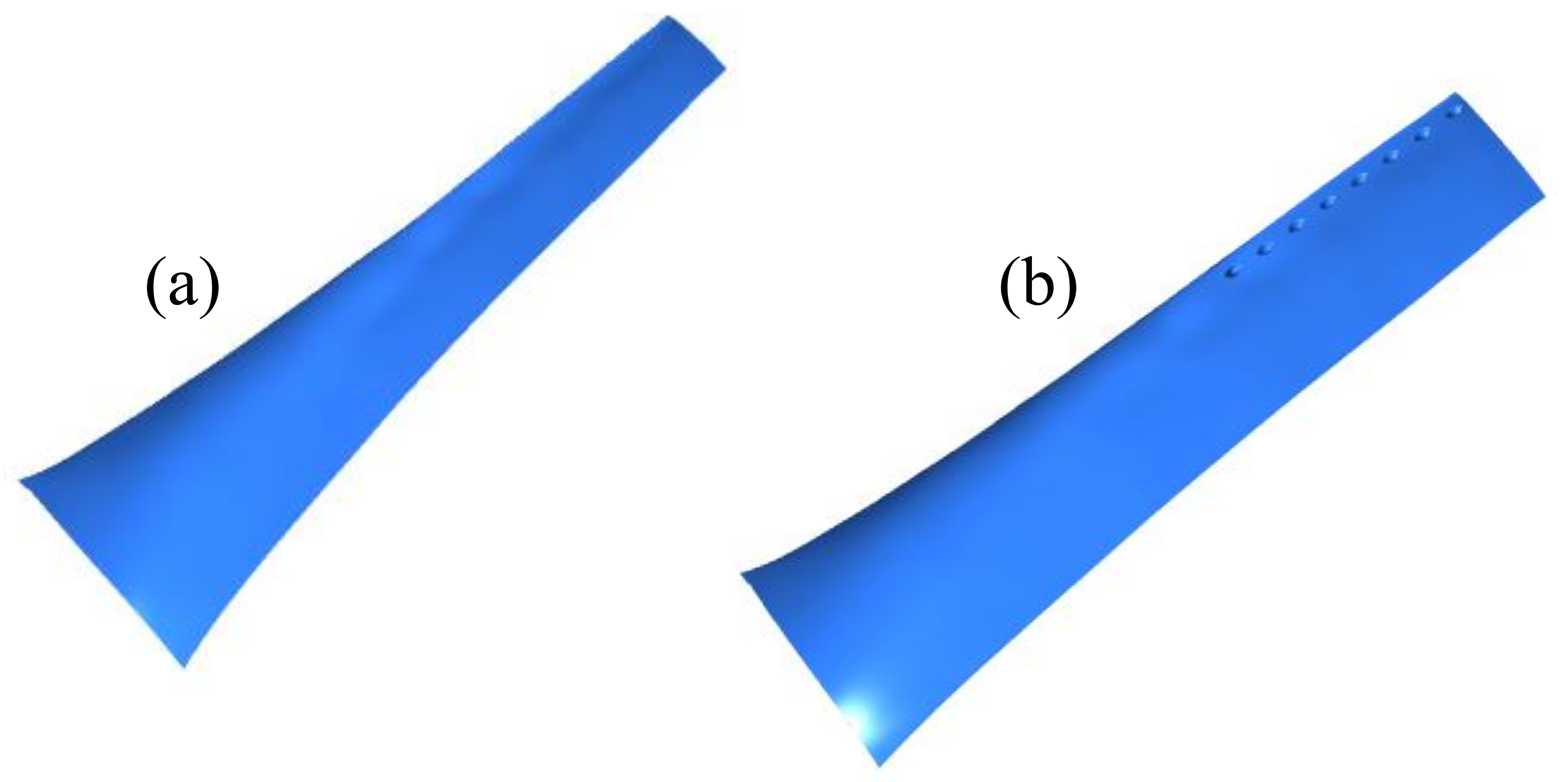

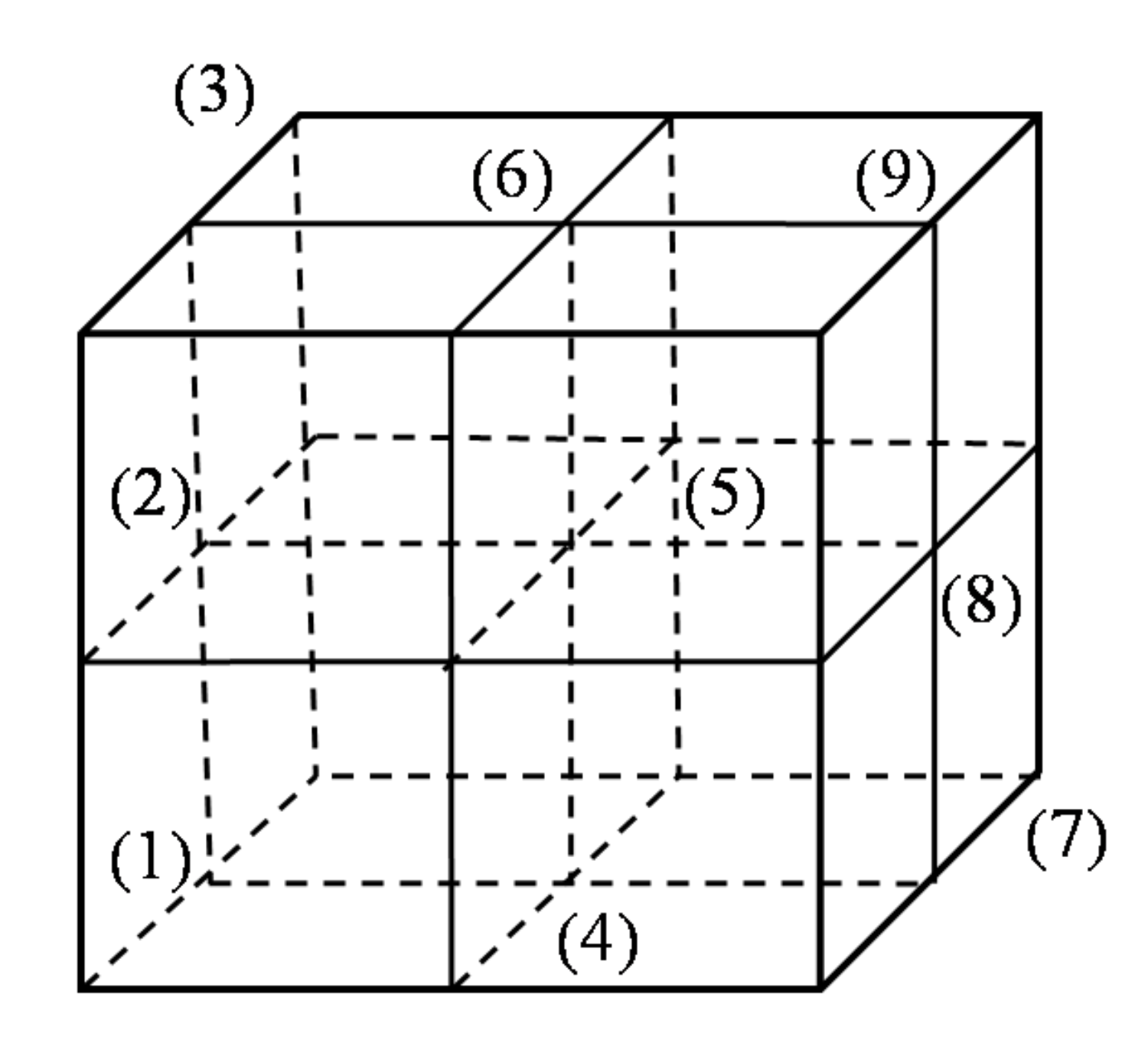
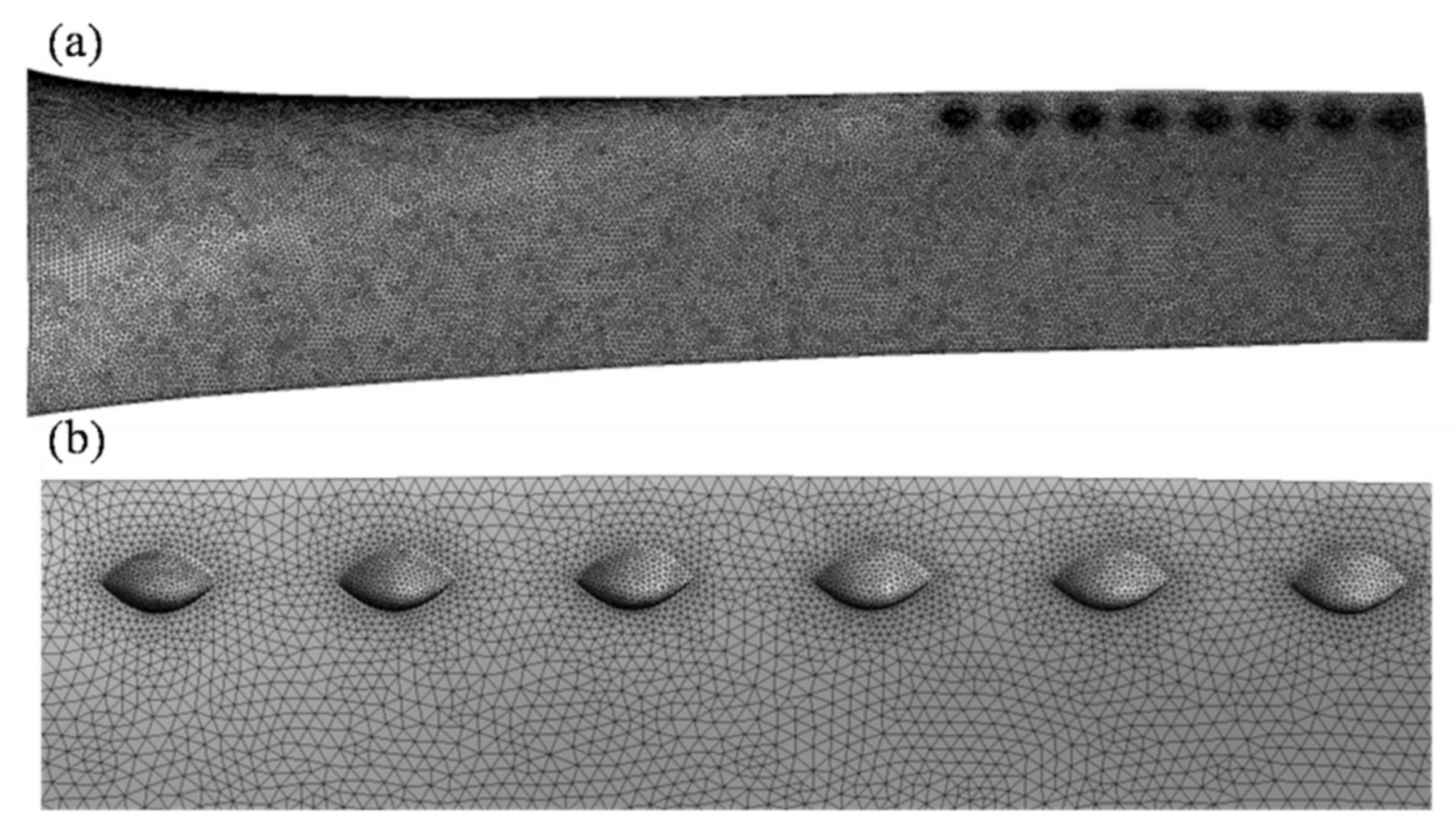

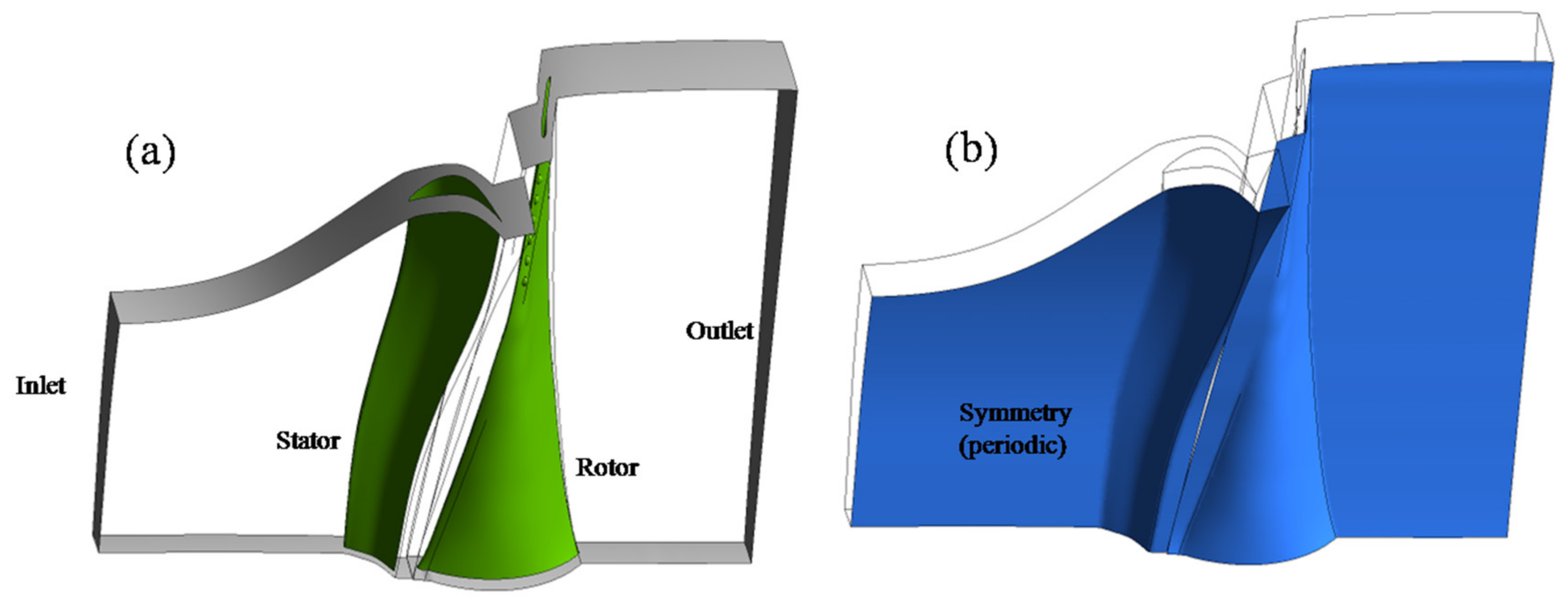

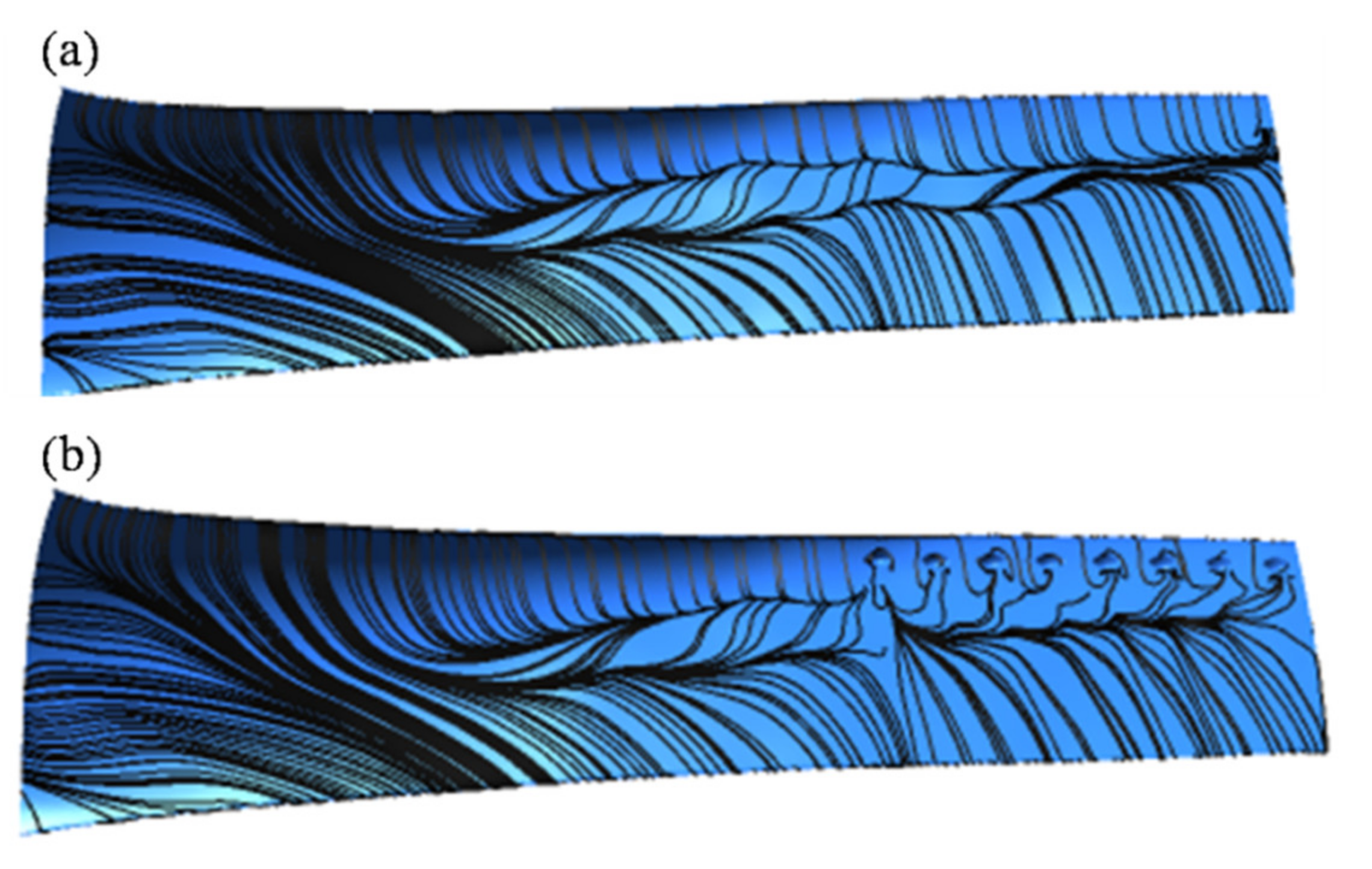

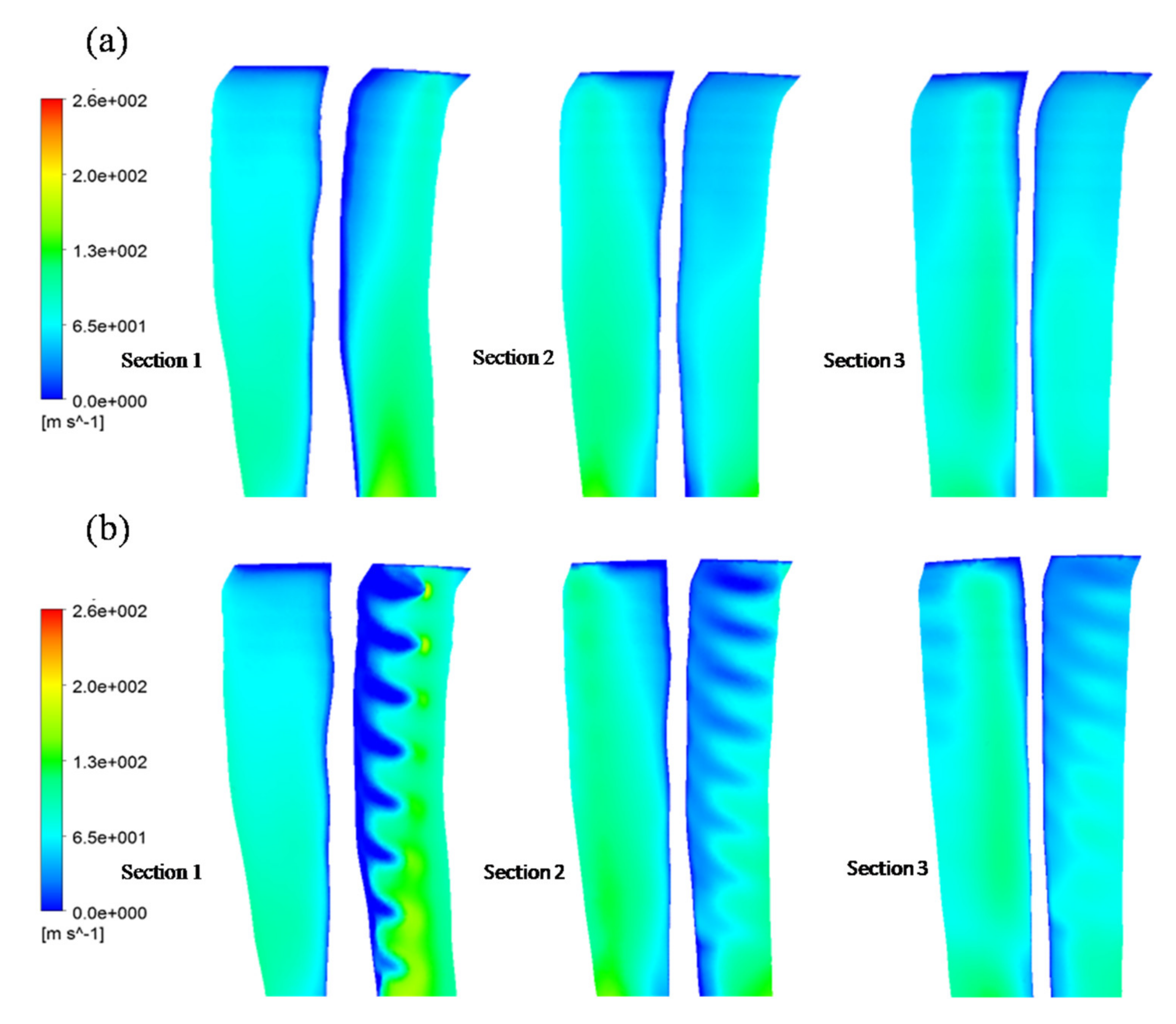
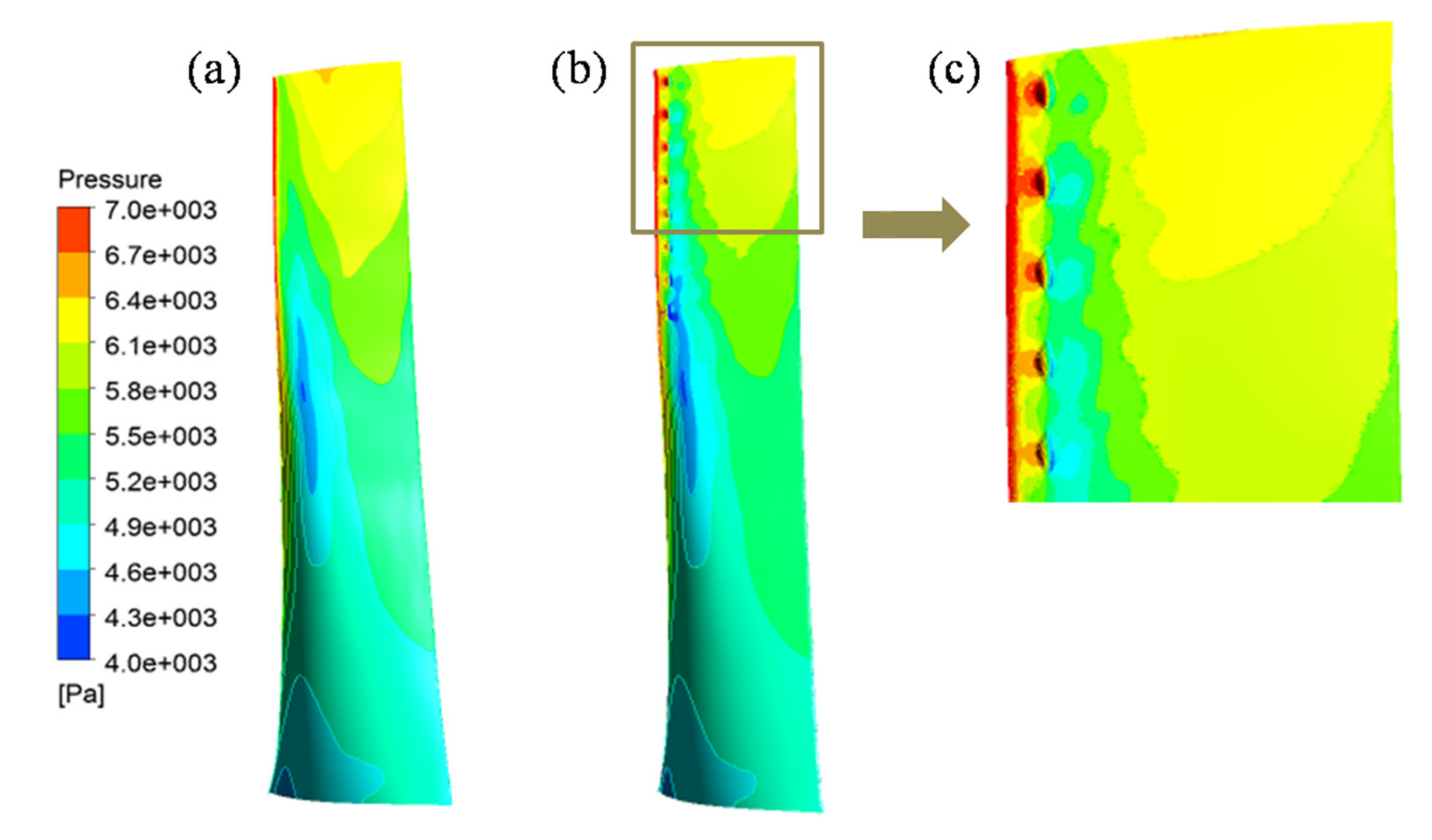
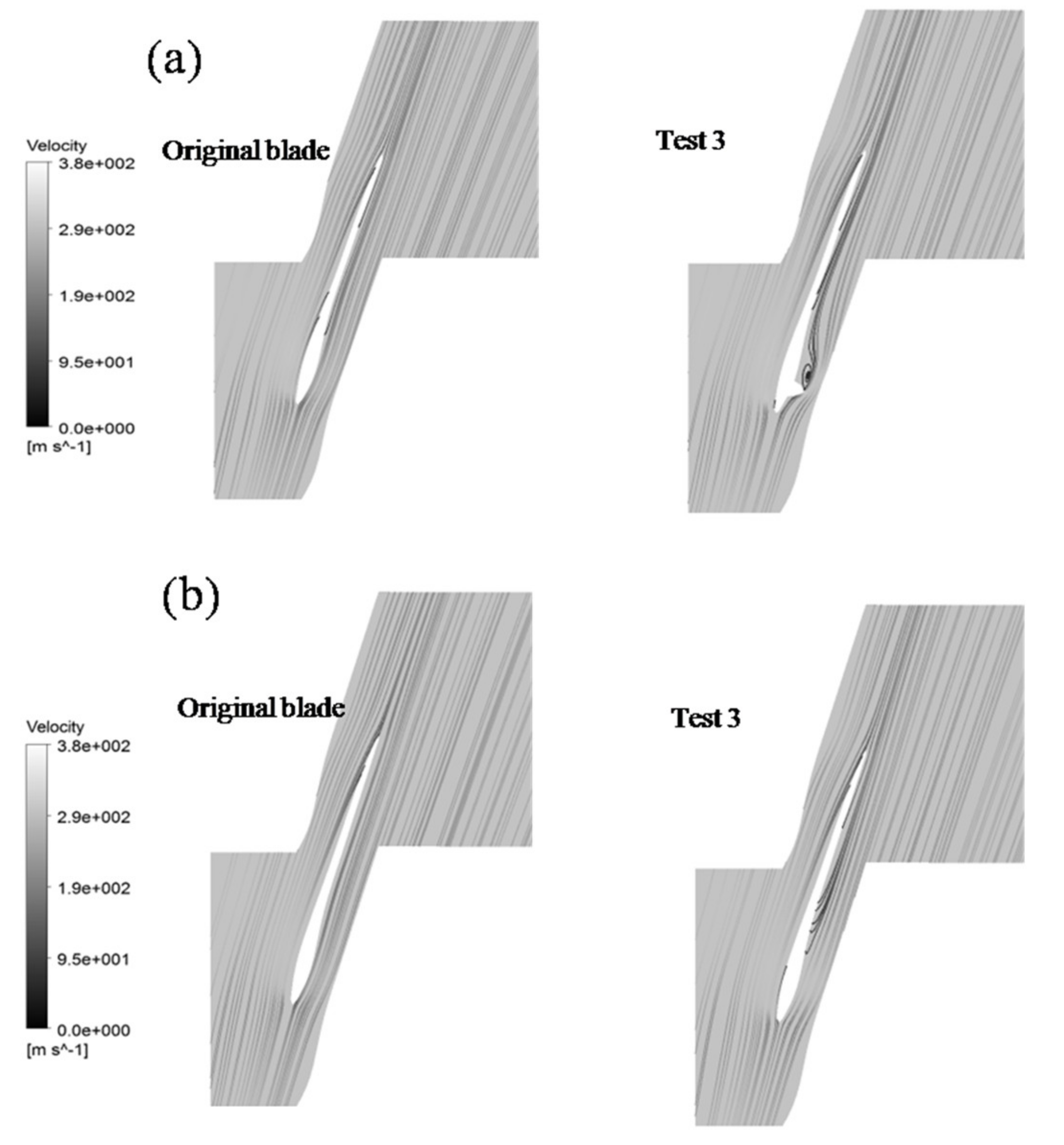
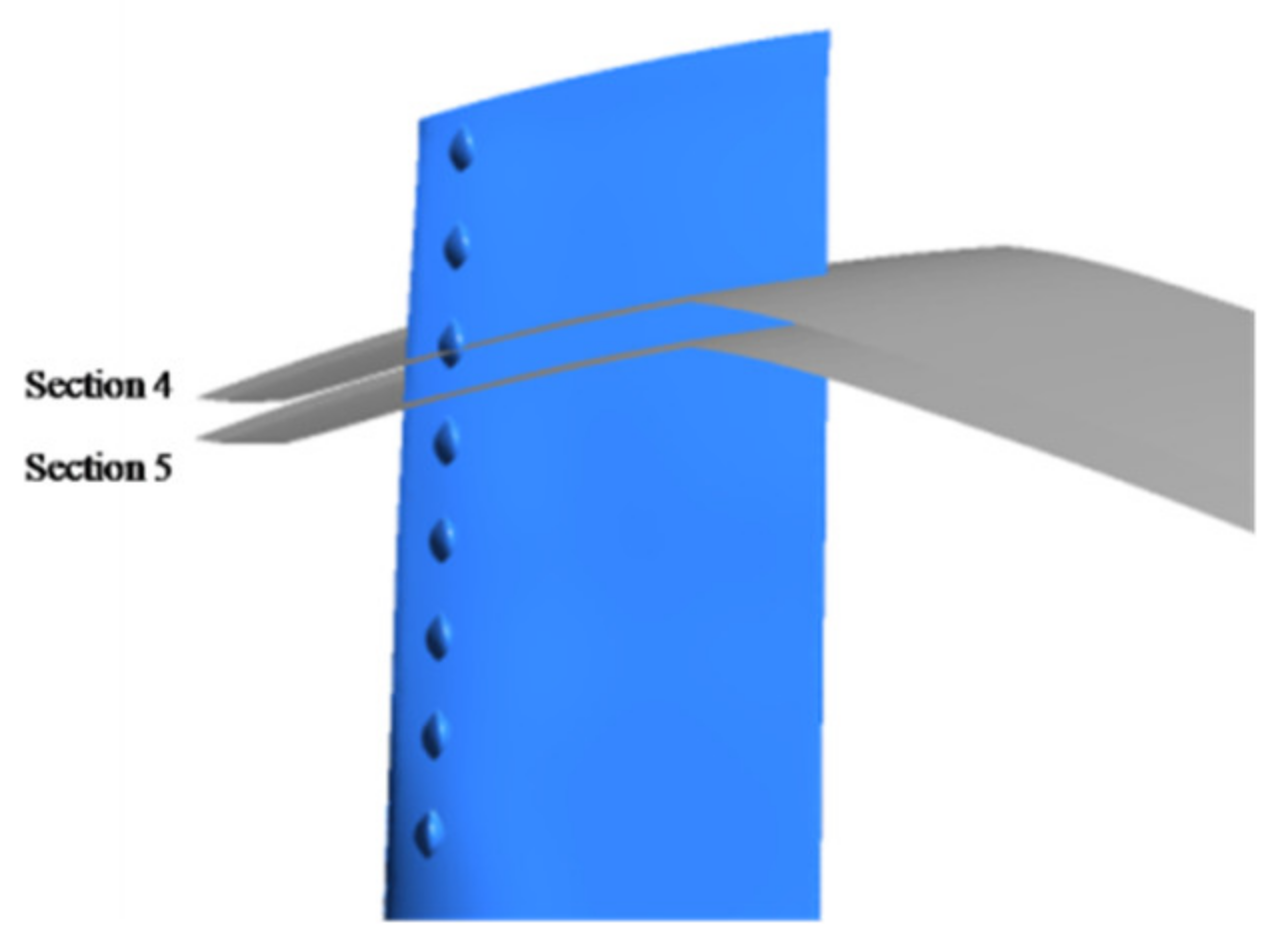
| Test | ||||
|---|---|---|---|---|
| 1 | 1 | 1 | 1 | 1 |
| 2 | 2 | 2 | 2 | 1 |
| 3 | 3 | 3 | 3 | 1 |
| 4 | 3 | 2 | 1 | 2 |
| 5 | 2 | 1 | 3 | 2 |
| 6 | 1 | 3 | 2 | 2 |
| 7 | 1 | 2 | 3 | 3 |
| 8 | 2 | 3 | 1 | 3 |
| 9 | 3 | 1 | 2 | 3 |
| Level | ||||
|---|---|---|---|---|
| 1 | 1.09% | 0.55% | 6% | 3% |
| 2 | 1.64% | 0.66% | 8% | 4% |
| 3 | 2.19% | 0.77% | 10% | 5% |
| No. of Elements (Million) | Coarse | Medium | Fine |
|---|---|---|---|
| Total | 1.48 | 2.35 | 4.04 |
| Case | Gm | Inlet Total Temperature | Outlet Static Pressure |
|---|---|---|---|
| 1 | 100% | 329.8 K | 5.4 kPa |
| 2 | 40% | 329.8 K | 5.4 kPa |
| Test | Non-Dimensional Blade Axial Torque at Case 1 | Non-Dimensional Blade Axial Torque at Case 2 |
|---|---|---|
| 1 | 1.76% | 5.89% |
| 2 | 1.42% | 13.07% |
| 3 | 0.90% | 33.32% |
| 4 | 1.68% | 10.88% |
| 5 | 1.41% | 11.39% |
| 6 | 1.38% | 20.85% |
| 7 | 1.37% | 12.90% |
| 8 | 1.72% | 15.75% |
| 9 | 1.67% | 11.73% |
| Parameter | Level | Average Value Non-Dimensional Blade Axial Torque at Case 2 | R at Case 2 |
|---|---|---|---|
| Wavelength | 1 | 13.21% | 5.44% |
| 2 | 13.40% | ||
| 3 | 18.65% | ||
| Amplitude | 1 | 9.67% | 13.63% |
| 2 | 12.29% | ||
| 3 | 23.30% | ||
| Position | 1 | 10.84% | 8.37% |
| 2 | 15.22% | ||
| 3 | 19.21% | ||
| Thickness | 1 | 17.43% | 3.97% |
| 2 | 14.37% | ||
| 3 | 13.46% |
© 2020 by the authors. Licensee MDPI, Basel, Switzerland. This article is an open access article distributed under the terms and conditions of the Creative Commons Attribution (CC BY) license (http://creativecommons.org/licenses/by/4.0/).
Share and Cite
Zhang, J.; Wu, F.; Wang, C.; Mei, Z.; Han, A.; Xie, D. The Effect of Suction Side Tubercles on Torque Output of a Steam Turbine Low-Pressure Last Stage Blade. Energies 2020, 13, 1889. https://doi.org/10.3390/en13081889
Zhang J, Wu F, Wang C, Mei Z, Han A, Xie D. The Effect of Suction Side Tubercles on Torque Output of a Steam Turbine Low-Pressure Last Stage Blade. Energies. 2020; 13(8):1889. https://doi.org/10.3390/en13081889
Chicago/Turabian StyleZhang, Jing, Fan Wu, Chun Wang, Ziyue Mei, An Han, and Danmei Xie. 2020. "The Effect of Suction Side Tubercles on Torque Output of a Steam Turbine Low-Pressure Last Stage Blade" Energies 13, no. 8: 1889. https://doi.org/10.3390/en13081889
APA StyleZhang, J., Wu, F., Wang, C., Mei, Z., Han, A., & Xie, D. (2020). The Effect of Suction Side Tubercles on Torque Output of a Steam Turbine Low-Pressure Last Stage Blade. Energies, 13(8), 1889. https://doi.org/10.3390/en13081889




